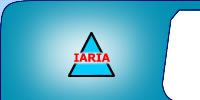

 |
The Third International Conference on Creative Content Technologies CONTENT 2011 |
| Call for Papers |
The CONTENT 2011 event, The Third International Conference on Creative Content Technologies, targets advanced concepts, solutions and applications in producing, transmitting and managing various forms of content and their combination. Multi-cast and uni-cast content distribution, content localization, on-demand or following customer profiles are common challenges for content producers and distributors. Special processing challenges occur when dealing with social, graphic content, animation, speech, voice, image, audio, data, or image contents. Advanced producing and managing mechanisms and methodologies are now embedded in current and soon-to-be solutions.
CONTENT 2011 is aimed at technical papers presenting research and practical results, industrial small- and large-scale systems, challenging applications, position papers addressing the pros and cons of specific topics, such as those being discussed in the standard fora or in industry consortia, survey papers addressing the key problems and solutions on any of the topics, short papers on work in progress, and panel proposals.
We welcome technical papers presenting research and practical results, position papers addressing the pros and cons of specific proposals, such as those being discussed in the standard fora or in industry consortia, survey papers addressing the key problems and solutions on any of the above topics short papers on work in progress, and panel proposals.
Industrial presentations are not subject to the format and content constraints of regular submissions. We expect short and long presentations that express industrial position and status.
Tutorials on specific related topics and panels on challenging areas are encouraged.
The topics suggested by the conference can be discussed in term of concepts, state of the art, research, standards, implementations, running experiments, applications, and industrial case studies. Authors are invited to submit complete unpublished papers, which are not under review in any other conference or journal in the following, but not limited to, topic areas.
All tracks are open to both research and industry contributions.
BASICS: Content producers/distributors
Product-innovation and creative content platforms
Creative processes
Product and content innovation
Knowledge representation for content creativity
Content injection, cashing, storage, and distribution
Producing and transmitting streaming content
Content localization services
Content and customers profiles
Documenting and content authoring
Authorizing topic-based content
Content customization and metadata
On-demand content
Content retrieval from archives (alarm-based, time stamp-based)
Content management solutions and systems
Unstructured content environment
Multi-channel content delivery/publishing strategies
Content reuse
WEBCONTENT: Web content
Architectures and frameworks for Web content
Web content mining
Content retrieval on multimedia Web
XML and non-XML Web content
Ontology and semantic for processing Web content
Recommenders for Web content
Content-driven workflow design and management
Web content performance, accuracy, security, and reliability
Web content modeling
Web content-based applications
SOCIAL: Tools for producing and handling social content
On-line content
Games technologies
Multi-user and mono-user games
For-kids contents and programs
Social content and tools (YouTube, FaceBook, etc.)
Open portals (e-Democracy, e-Health, etc.)
Email lists challenges (membership, spamming, etc.)
Virtual social communities
Hybrid real and virtual reality technologies
GRAPHICS: 3D Graphics
Interactive 3D graphics
High-performance 3D graphics
Mixed and augmented reality
Interactive on-line gaming
Animated humanoids and complex reactive characters
3D documents and web/multimedia
User-interface for real-time 3D graphics and virtual environments
Innovative 3D web applications /industry, science, medicine, technology, culture/
3D content creation technologies and tools
Interactive 3D graphics for mobile devices
ANIMA: Animation/cinematography
Computer animation
Computational cinematography
Virtual videography
Autonomous interactive characters
Traditional animation and 3D computer animation
Re-cinematography
Casual video
Cinematography
Image stabilization
Virtual Cinematography
Relighting through computation
MEDIMA: Medical image producing, transmission and management
Medical image devices, mechanisms and procedures
Medical imaging systems
Medical image capture and processing
Feature extraction and pattern recognition
Matching and computing anatomical atlases
Surface and volume registration
Medical image analysis (static and motion analysis)
Medical image analysis (functional, metabolic )
Multi-modal image analysis
Image segmentation
Multidimensional data visualization
Statistical methods (population-based analysis)
Image guided diagnosis, surgery and therapy
Medical image transmission and storage (protocols, databases)
AUDIO: Audio producing, transmission and management
Audio transmission and reception systems and devices
Digital audio transmission signal processing
Audio transmission over Internet
Audio Multiplexing Transmission Systems
Stereo audio transmission signal
Digital infrared audio transmission
Multi-stream and multi-path audio transmission
Wireless-compressed digital audio transmission
Perceptual coding for audio transmission and storage
Laser audio transmission
Synchronizing video and audio transmission
Wide-band audio transmission
Index-frame audio transmission
Digital audio transmission rights
Noise in wireless audio transmission
Audio tools and products
Standards
DATA: Data transmission and management
Data transmission and reception mechanisms and techniques
Enhanced tools for video data integrity
Data mining, filtering, and reporting
Secure data transmission
Transmission media and data encoding
Text reading devices (super-pen, pen-elite, reading-pen)
Scanned and generated lossy (progressive) multi-page text
(Visually) lossless mechanisms
Pricing data transmission
Differential data transmission systems
Data transmission equipments and transmission rates
Delay-constrained data transmission
Undersea and satellite data transmission techniques
Performance evaluation of data transmission
Multicast data transmission
High speed data transmission
Data transmission control
Integrity and privacy in data transmission
Data transmission standards
VOICE: Voice producing, transmission and management
Planning and implementing voice networks and systems
Voice transmission systems
Voice transmission performance
Quality real-time voice transmission
Metrics for quality of voice transmission
Stereophonic voice transmission systems
Header compression for VoIP over WLAN
Voice over IP solution for mobile radio interoperability
VoIP over cable TV networks
VoIP over Wi-Max
WiFi and cellular dual mode phones and services
Voice over WLANs and Wi-Fi to cellular roaming
Voice transmission via the Internet
Wi-Fi voice transmission
Bluetooth-based Ad-Hoc networks for voice transmission
Standards for voice processing and transmission
VIDEO: Coding/Transmission/Processing
Video coding standards (H.264, SMPTE 421M, AVS-China)
Video coders and decoders
Video surveillance and privacy
Network video recorders
Video streaming
Video data integrity (error detection, error resilience, error concealment, tamper resistance)
Motion detection, object tracking
Distributed video coding
Video quality assessment
Omnidirectional video
3D video
IMAGE: Image producing, transmission and management
Model-based progressive image transmission
Wireless image transmission
Computer generated images
Image security, scrambling, and regions of interest
Timing requirements for image transmission
Transmission of still and moving images
Protocols for low bit rate
Error-prone image transmission
Energy efficient image transmission
Multi-technology image formation
Devices for image capturing and processing (cams, web-cams, etc.)
Scanning and sampling, quantization and halftoning, color reproduction
Image representation and rendering, display and printing systems
Image quality assessment
Image search and sorting, video indexing and editing
Integration of images and video with other media,
Image authentication and watermarking
Image storage, retrieval and multimedia
Image and video databases
Generic coding of moving pictures
Media stream packetization
Modes for archival playback
Image-based applications
Standard for image processing
Image analysis and segmentation
Image filtering, restoration and enhancement
Image representation and modeling
Pattern recognition
SPEECH: Speech producing, transmission and management
Tooling, architectures, components and standards
Voice modulation, frequencies
Linguistics, phonology and phonetics
Discourse and dialogue
Speech analysis, synthesis, coding, and recognition
Speech enhancement and noise reduction
Speech features, production, and perception
Speech coding and transmission
Speech signal processing
Spoken language generation and synthesis
Speech QoS enhancement
Speaker characterization and recognition
Spoken language resources and annotation
Spoken/Multi-modal dialogue technology and systems
Spoken language information extraction/retrieval
Speech transmission technology for the aged and disabled
Audio-visual speech processing
Biomedical applications of speech analysis
Spoken document retrieval
Speech processing in a packet network environment
Automatic speech recognition in the context of mobile communications
Human factors in speech and communication systems
Automatic speech recognition and understanding technology
Speech to text systems
Spoken dialog systems
Multilingual language processing
New applications of spoken language technology and systems
INSTRUCTION FOR THE AUTHORS
Authors of selected papers will be invited to submit extended versions to one of the IARIA Journals.
Publisher: XPS (Xpert Publishing Services)
Archived: ThinkMindTM Digital Library (free access)
Prints available at Curran Associates, Inc.
Articles will be submitted to appropriate indexes.
Important deadlines:
Due to Easter holidays, we are allowing submissions until: May 14, 2011| Submission (full paper) | |
| Notification | |
| Registration | June 30, 2011 |
| Camera ready | June 30, 2011 |
Only .pdf or .doc files will be accepted for paper submission. All received papers will be acknowledged via an automated system.
Final author manuscripts will be 8.5" x 11", not exceeding 6 pages; max 4 extra pages allowed at additional cost. The formatting instructions can be found on the Instructions page. Helpful information for paper formatting can be found on the here.
Your paper should also comply with the additional editorial rules.
Once you receive the notification of paper acceptance, you will be provided by the publisher an online author kit with all the steps an author needs to follow to submit the final version. The author kits URL will be included in the letter of acceptance.
Posters
Posters are welcome. Please submit the contributions following the instructions for the regular submissions using the "Submit a Paper" button and selecting the contribution type as poster. Submissions are expected to be 6-8 slide deck. Posters will not be published in the Proceedings. One poster with all the slides together should be used for discussions. Presenters will be allocated a space where they can display the slides and discuss in an informal manner. The poster slide decks will be posted on the IARIA site.
For more details, see the Posters explanation page.
Work in Progress
Work-in-progress contributions are welcome. Please submit the contributions following the instructions for the regular submissions using the "Submit a Paper" button and selecting the contribution type as work in progress. Authors should submit a four-page (maximum) text manuscript in IEEE double-column format including the authors' names, affiliations, email contacts. Contributors must follow the conference deadlines, describing early research and novel skeleton ideas in the areas of the conference topics. The work will be published in the conference proceedings.
For more details, see the Work in Progress explanation page
Technical marketing/business/positioning presentations
The conference initiates a series of business, technical marketing, and positioning presentations on the same topics. Speakers must submit a 10-12 slide deck presentations with substantial notes accompanying the slides, in the .ppt format (.pdf-ed). The slide deck will not be published in the conference’s CD Proceedings. Presentations' slide decks will be posted on the IARIA's site. Please send your presentations to [email protected].
Tutorials
Tutorials provide overviews of current high interest topics. Proposals should be for three hour tutorials. Proposals must contain the title, the summary of the content, and the biography of the presenter(s). The tutorials' slide decks will be posted on the IARIA's site. Please send your proposals to [email protected]
Panel proposals:
The organizers encourage scientists and industry leaders to organize dedicated panels dealing with controversial and challenging topics and paradigms. Panel moderators are asked to identify their guests and manage that their appropriate talk supports timely reach our deadlines. Moderators must specifically submit an official proposal, indicating their background, panelist names, their affiliation, the topic of the panel, as well as short biographies. The panel's slide deck will be posted on the IARIA's site.
For more information, [email protected]
Workshop proposals
We welcome workshop proposals on issues complementary to the topics of this conference. Your requests should be forwarded to [email protected].